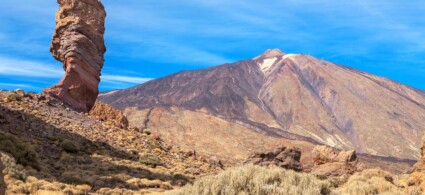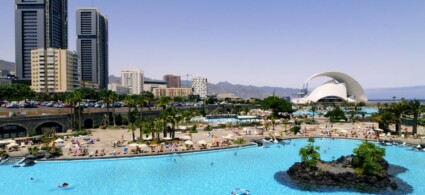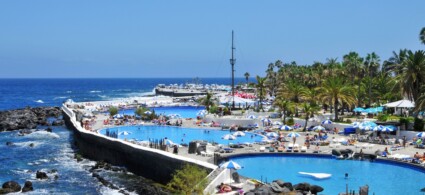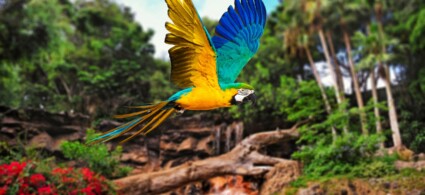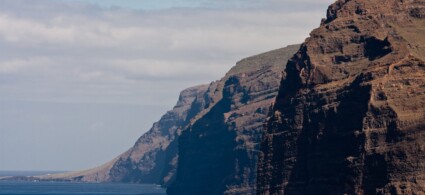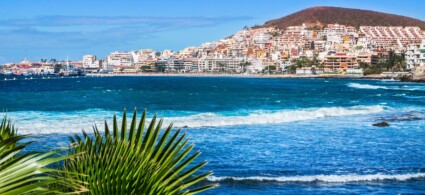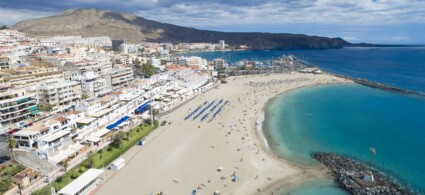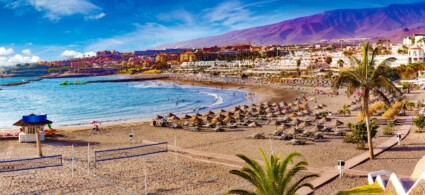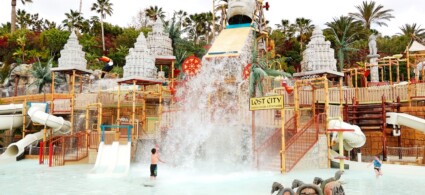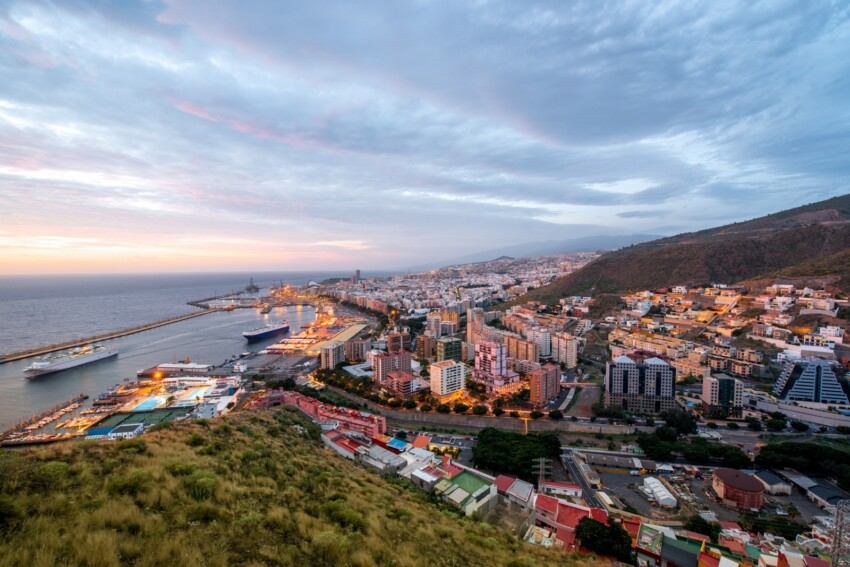

The volcanic island of Tenerife, the largest of the Canary Islands archipelago, lies between the island of Gran Canaria and the small island of La Gomera.
Triangular in shape, the island of Tenerife boasts the highest peak in Spain, Teide, at 3,718 metres above sea level, and an extraordinary natural environment.
Santa Cruz de Tenerife, the island’s capital, the Unesco World Heritage city of La Laguna and Tegueste are the island’s main urban centres. The most popular resorts in Tenerife are Puerto de la Cruz, La Orotava, Isla Baja, Playa de las Americas and Los Cristianos.
The south of Tenerife, from Candelaria to Santiago del Teide, has been developing a lot in terms of tourism in recent years due to its beautiful beaches.
The main attractions of Tenerife are of course the golden and black sand beaches , but the natural areas are also very popular.
Beach-lovers should not miss the areas of Arona, Costa Adeje, Playa Teresitas, Lago Martianez, Bajamar and Punta del Hidalgo while hiking enthusiasts will not be disappointed with the Anaga Mountains, the Teide National Park, the Barranco del Infierno, the Corona Forest Natural Park and the Cueva del Viento Sobrado, a volcanic tunnel stretching more than 17 kilometres.
Tenerife also has several archaeological sites including the La Cambados area, El Barranco de Ray and the pyramids of Guimar.
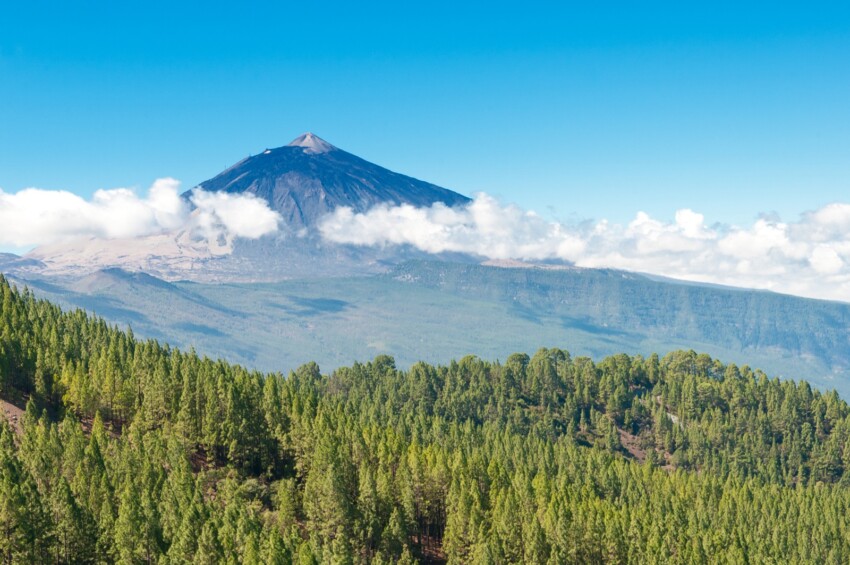
The Mount Teide National Park, established in 1954 to protect the landscape of great beauty and high ecological value in the centre of Tenerife, is the largest in the Canary Islands.
The park, declared a World Heritage Site by Unesco in 2007, extends around the third highest volcano in the world and the largest volcano in Spain, Teide, whose last eruption dates back to 1798, and includes an enormous volcanic crater 48 kilometres in diameter and extraordinarily complex landscapes composed of lava flows.
Teide is a volcanic formation situated on an ancient and gigantic caldera formed by two semicircular depressions separated by a series of rocks called Roques de García.
The best way to reach the highest point of the peak is by cable car. Once at the top, you can enjoy breathtaking views of nearby Gran Canaria, La Palma, La Gomera and El Hierro. The park can be explored independently or through guided hikes. The ascent on foot takes about 5-6 hours.
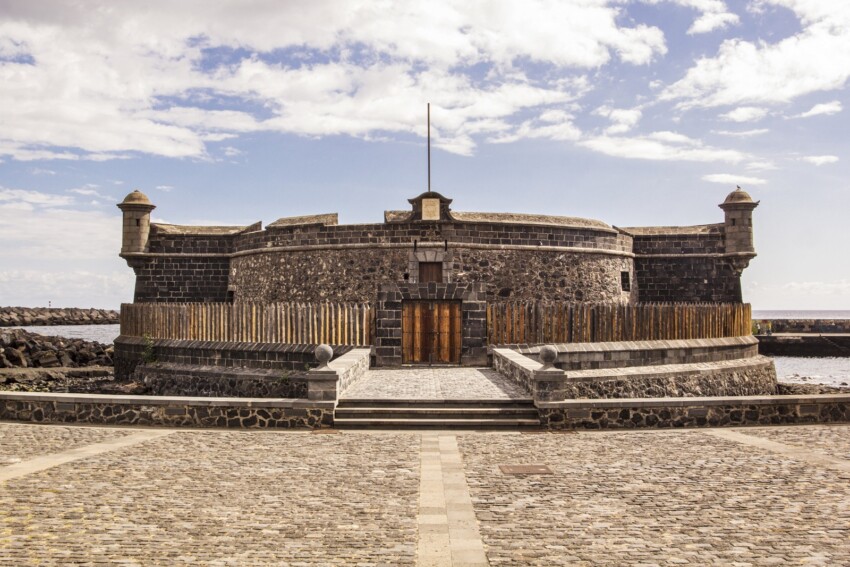
The lively and cosmopolitan coastal capital Santa Cruz de Tenerife is located at the north-eastern end of Tenerife and boasts one of the most important ports in the Atlantic Ocean.
With 58 kilometres of city coastline, Santa Cruz is home to some of the island’s most famous beaches including Playa Teresitas, a large golden sand beach surrounded by palm trees, Playa Las Gaviotas, Playa Los Llanos, Playa de Anaga, the 2 Tabaiba beaches and the Cesar Manrique Maritime Park.
Numerous monuments, places of interest and museums enrich the charming Santa Cruz. Among the most important buildings are the Auditorio de Tenerife, Plaza de Pedro Schwartz, the Castillo de San Juan, the Iglesia de la Concepciónla Plaza de la Paz, the Tea and the Museo de Bellas Artes.
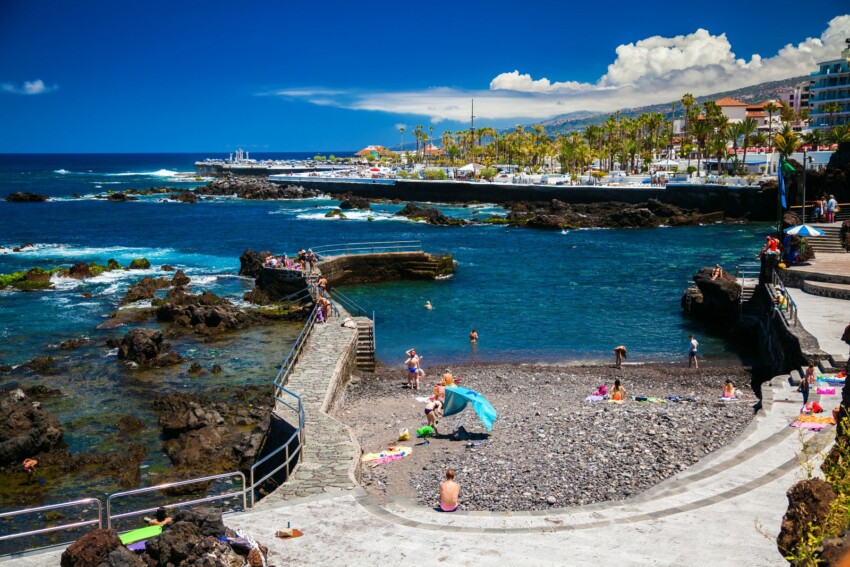
Tenerife’s main tourist resort is Puerto de la Cruz, a cosy, sophisticated-looking town that attracts thousands of tourists from all corners of the world every year, just 4 kilometres from La Orotava and just 30 from Santa Cruz de Tenerife.
The cosmopolitan city of Puerto de la Cruz is located along the northern coast of the island, at the foot of El Teide, and manages to amiably combine traditional Canarian architecture with luxury hotel facilities. The small harbour, wide boulevards and historical buildings of the San Filipe Castle, the church of Nuestra Senora de la Pena and the hermitage of San Telmo are ideal places for a stroll.
The area around the old fishing port is full of cobbled streets lined with traditional colonial-style cafés and small restaurants.
A short distance from the city are the exceptional volcanic sand beaches, the wonderful saltwater pools of Lago Martianez, a work by the artist Manrique that exceptionally blends design and nature, the beautiful beach of Playa Jardin and Punta Brava.
The city’s botanical garden, where floral species from all over the world can be admired, and Loro Parque, an adventure park where dolphins, orcas and sea lions can be admired, are very beautiful. Just outside the city, nature lovers can enjoy the beautiful scenery of the Orotava Valley.
Puerto de la Cruz is an ideal destination for discerning travellers seeking tranquillity but also for groups of friends looking for a lively nightlife.
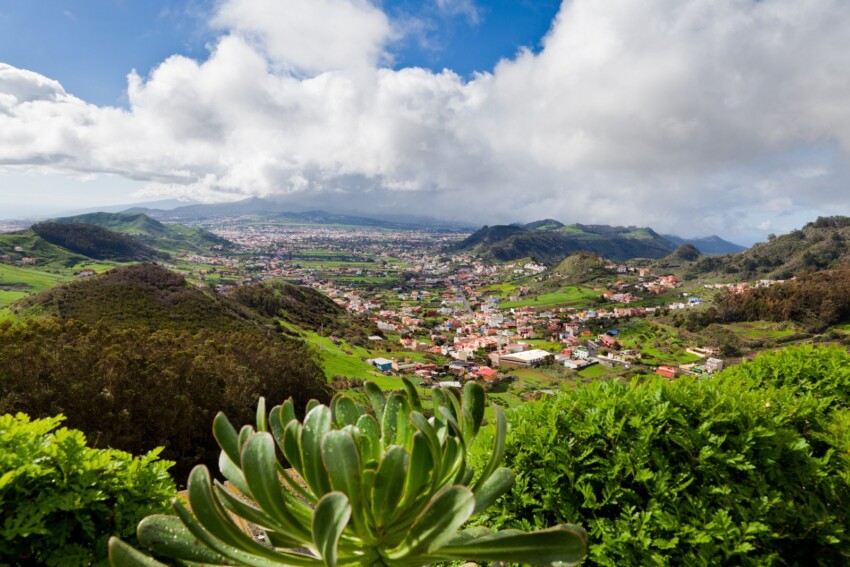
San Cristobal de la Laguna, one of the most charming towns in the Canary Islands, is located in the northern part of Tenerife, in the Aguere Valley, at the foot of the Anaga Mountains, 10 kilometres from Santa Cruz de Tenerife.
The historic centre is a jewel of rare beauty where picturesque buildings with eccentric façades, sumptuous villas and typical shops overlook cobbled streets.
Listed as a UNESCO World Heritage site, La Laguna was Spain ‘s first unfortified colonial city and is divided into the Upper Town, Villa de Arriba, and the Lower Town, Villa de Abajo.
Founded in 1497 by Alonso Fernández de Lugo, the city first developed without any plans around the church of La Concepcion, but then grew according to an urban plan inspired by Leonardo da Vinci’s model. Among the beautiful 18th century buildings are the Casa de Montanes, the Casa de los Jesuitas, Casa Salazar and the Casa de la Alhondiga.
La Laguna is a university town and is renowned for its lively nightlife.
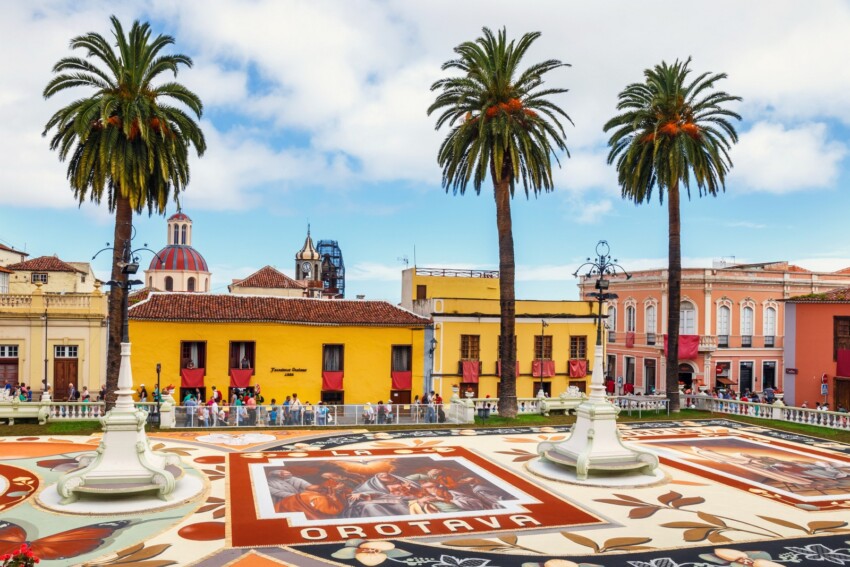
The colonial town of La Orotava is located near the northern coast of Tenerife, just 7 kilometres from Puerto de la Cruz, and is famous for its Castilian architecture, characterised by its balconies and inner courtyards, cobbled streets and lively squares.
Surrounded by a lush valley where grapevines are cultivated, the charming old town of La Orotava is 335 metres above sea level and has its heart in Plaza Costitucion where you can admire the 19th-century French-style Jardines de los Marquesado de la Quinta Roja, the Iglesia de San Agustin and the imposing Liceo de Taoro building.
Don’t miss the Iglesia de la Concepcion, one of the most beautiful Baroque buildings in the Canary Islands, and the Doce Casas, 12 beautiful historical buildings.
Perhaps not everyone knows that one of the most important products of the Canary Islands is bananas and in Tenerife there are numerous high quality plantations that can boast the ‘Protected Geographical Indication’ seal. If you are interested in learning more or simply want to immerse yourself in a banana field, you should visit a plantation in La Orotava, where you can learn more about the history and cultivation of this iconic fruit.
Not far from La Orotava are the volcanic sand beaches of Playa El Bollullo, Playa de Los Patos and Playa de El Ancon.
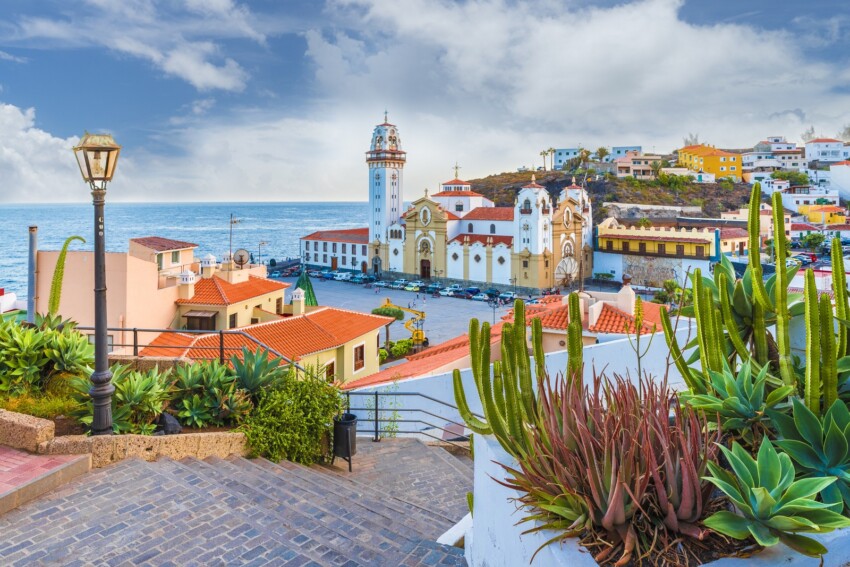
The town of Candelaria is located along the northeast coast of Tenerife about 20 kilometres south of the island’s capital Santa Cruz de Tenerife.
Famous for the Basilica of Our Lady, the patron saint of the Canary Islands archipelago, and also known as Villa Mariana de Candelaria, the town is shrouded in the legend of the apparition of the Virgin Mary to two shepherds in 1390, witnessed by a Gothic-style sculpture. Statues of the 9 native kings of Tenerife can also be admired in Plaza de la Patrona de Canarias.
A destination mainly for religious tourism, Candelaria is also an ideal destination for sea lovers. Picturesque corners coexist with modern buildings, creating a pleasant seaside resort.
Very beautiful is Playa de La Candelaria, a black sandy beach that is easily accessible from the centre and conveniently connected to the island’s other resorts.
Candelaria is about 46 kilometres from Tenerife South Airport and 24 kilometres from Tenerife North Airport.
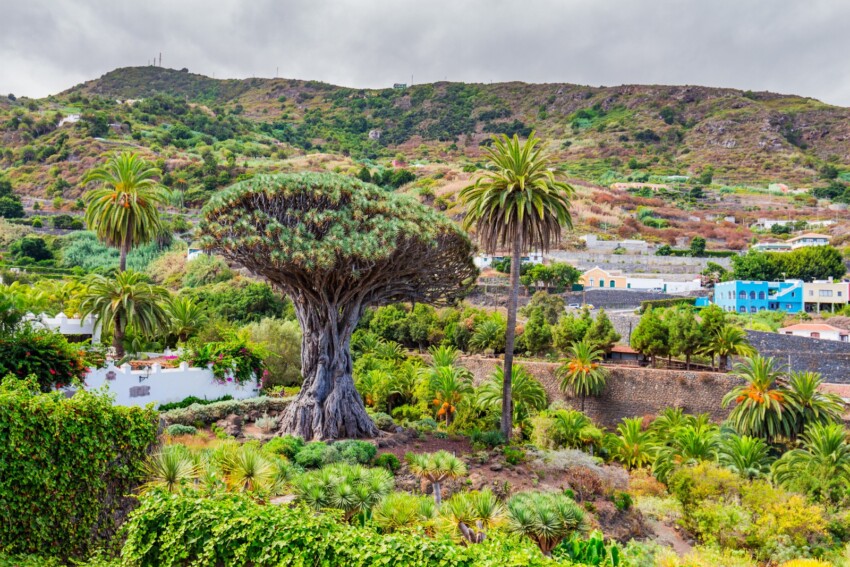
Icod de Los Vinos is located on a slope stretching down to the sea along the north-eastern coast of Tenerife in a strategic point for exploring the island.
Surrounded by a valley, from the town one can enjoy the fabulous landscapes of the Teide.
Founded in 1501, Icod is a surprising mix of old palaces, churches and stately homes. The Parque del Drago tree, a centuries-old tree that has become the symbol of the town, is located near the Museum of Sacred Art in the Church of San Marcos and not far away is Plaza de La Pila, considered by many to be the most beautiful of all the Canaries.
Very interesting are the Cueva de Viento, the largest volcanic cave in the world, 17 kilometres long, and ArtLandya, a small village dedicated entirely to dolls and teddy bears.
Playa de San Marcos, protected by shell-shaped cliffs, is a black sand volcanic beach in the north of Tenerife.
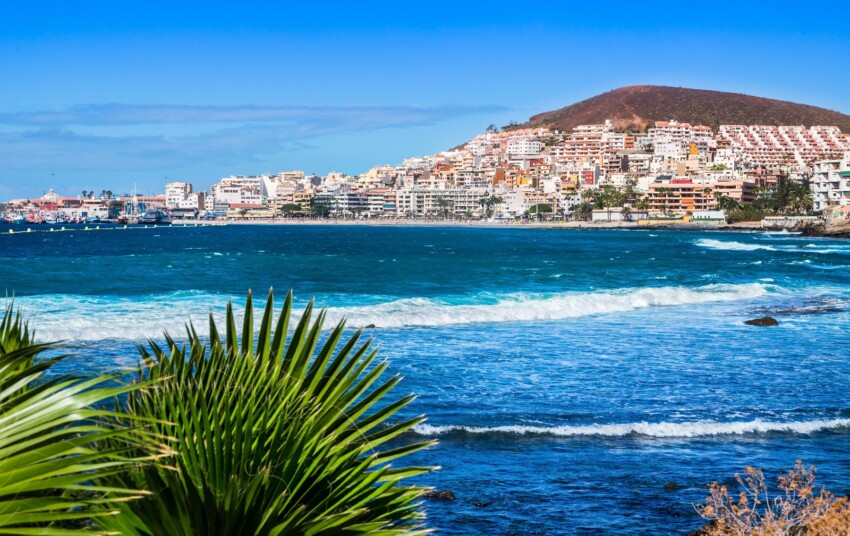
The lively resort town of Los Cristianos is located along the south-western coast of the island of Tenerife and boasts two beautiful golden sand beaches.
The town of Los Cristianos is framed between two protected natural areas, the Chayofita and Guaz mountains, a short distance from the popular resort area of Playa de Las Americas.
Popular with tourists, Los Cristianos offers a wide range of accommodation to suit all budgets, with excellent 4-star hotels, boat excursions, whale watching, mini cruises, sport fishing and excellent restaurants. At nightfall, the lively nightlife kicks off.
Sea lovers will appreciate Playa Las Vistas, easily recognisable by its impressive fountain, protected from waves and currents, and Playa de Los Cristianos, close to the harbour. The dark sand beach of Playa de Los Tarajales, overlooked by several hotels, is also popular.
Away from the beaches and the promenade, you will discover a labyrinth of shops, boutiques and numerous cafés and restaurants.
The tourist offer of Los Cristianos caters for a wide variety of holidaymakers, from families to couples. The little ones will appreciate Aqualand, Siam Park, a fantastic water theme park, the medieval shows at Castillo San Miguel and Monkey Park, a very interesting zoo.
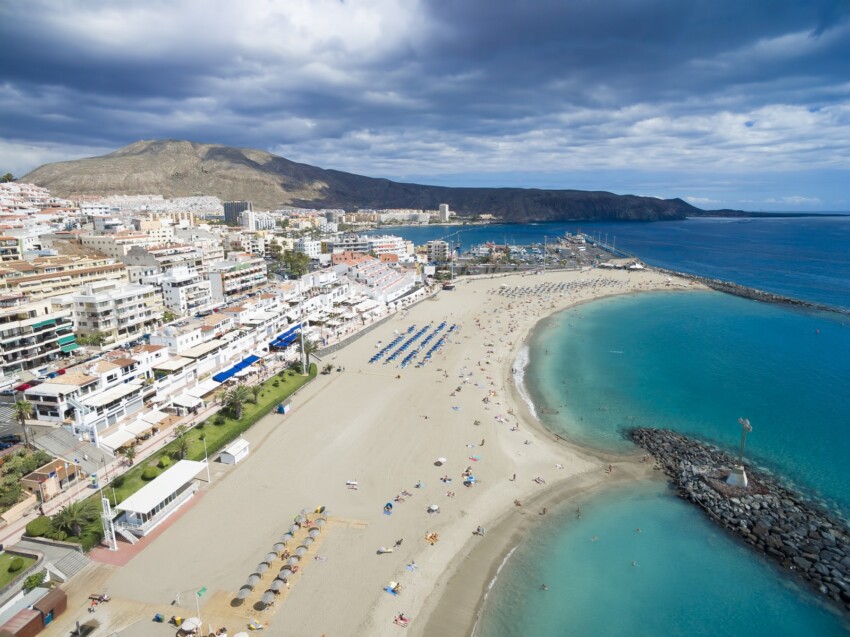
Playa de las Americas, the main resort in the southern part of Tenerife, is located on the sunny south-western coast of the island, opposite the shores of neighbouring La Gomera and next to Los Cristianos.
Built since the 1960s, this resort boasts large luxury hotels, excellent restaurants, trendy cafés, nightclubs and a beautiful long golden beach, imported from Africa, that will make your holiday unforgettable. This lively and fashionable resort will also allow you to enjoy paragliding, various water sports and numerous excursions.
The nightlife kicks off at sunset and goes wild in the clubs that line the beaches and the Veronicas area where the bars stay open until 6am. In fact, the party atmosphere and vibrant atmosphere animates Playa de las Americas throughout the day.
Sea lovers will appreciate the nearby beach of El Bobo, while green lovers will be more than satisfied by Golf las Americas, an 18-hole course with excellent views of the surrounding landscape, and Golf del Sur.
Tenerife South Airport is only a 20-minute drive from Playa de las Americas via the TF 1 motorway.
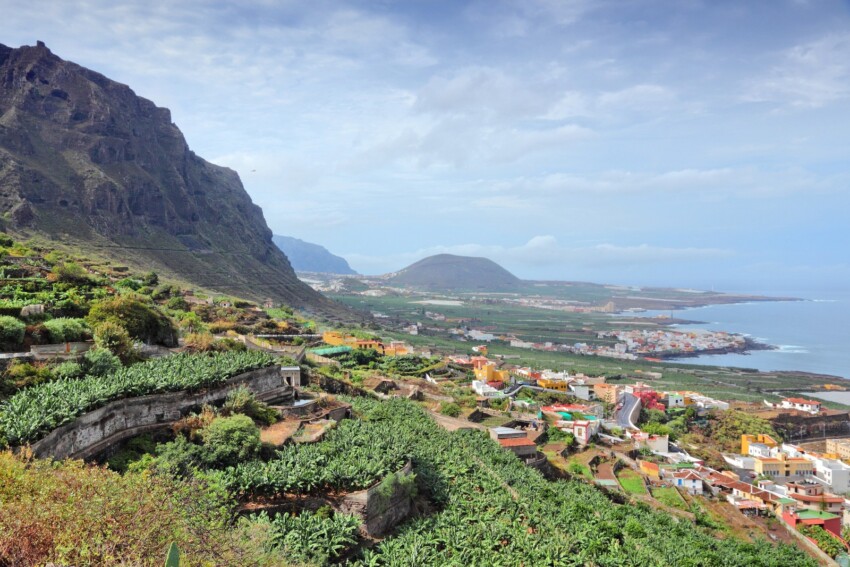
The village of Buenavista is located along the north-western coast of Tenerife, nestled between green valleys planted with banana trees, vines and fruit trees.
The architecture of the village, which is built around the 16th century Church of Los Remedios and its square, is of clear Andalusian influence and combines the tradition of the Portuguese settlers with that of the Guanches, giving it a timeless charm.
Buenavista is divided into three distinct geographical areas, Isla Baja, and Teno Teno Bajo, and is surrounded by the peaks of Mount Baracan and situated in a wide gorge. The area is particularly interesting for golf enthusiasts due to the presence of an 18-hole course designed by Severiano Ballesteros in full harmony with its surroundings and inaugurated in October 2003.
The village is located 71 kilometres from the island’s capital Santa Cruz de Tenerife and 40 kilometres from Puerto de La Cruz.
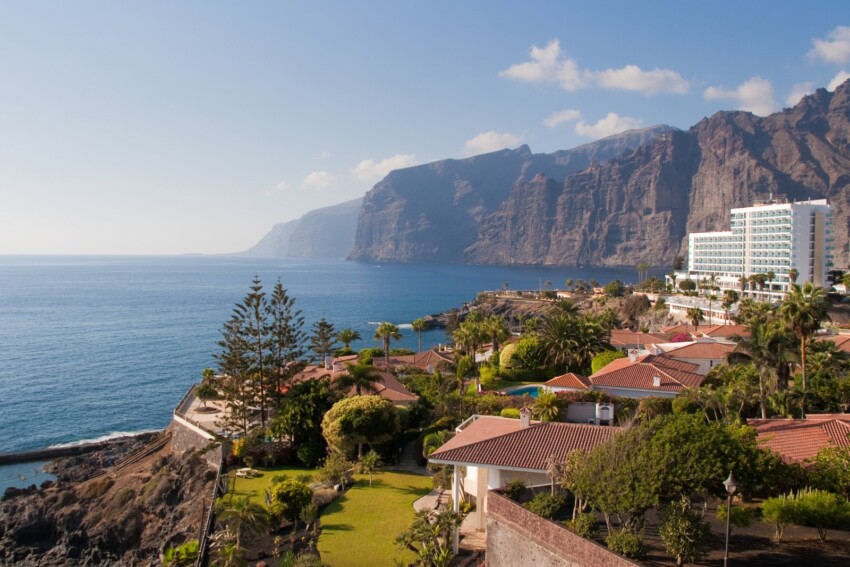
The fishing village of Puerto de Santiago, today a popular and quiet tourist centre, is located along the west coast of Tenerife, close to the cliffs of Los Gigantes and 13 kilometres from Santiago del Teide, and is mirrored on the shores of La Gomera.
Nestled around a small sheltered bay and beach, its main attraction is the beautiful black sand beach of Playa Las Arenas, which is only a 10-minute walk from the centre.
Hiking enthusiasts will appreciate the proximity of Mount Teide, the third highest volcano in the world, which is only a one-hour drive away.
The motorway network does not directly reach Puerto de Santiago, which is about 45 kilometres from Tenerife South, making this a more authentic and less hectic resort.
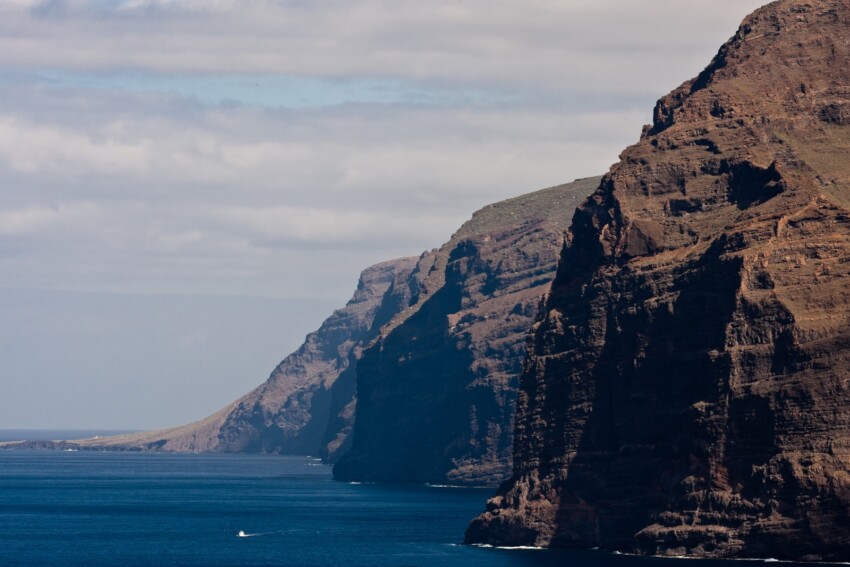
The resort of Los Gigantes is located along the west coast of Tenerife and is famous for its impressive cliffs overlooking the Atlantic Ocean, 600 metres high and stretching for 10 kilometres, which surround it like a majestic amphitheatre.
The spectacular visual impact of the vertical walls of the lava rock cliffs of Acantilados de Los Gigantes, the highest in all the Canary Islands, can be appreciated from the beach or from nearby Puerto Santiago, where one can embark on whale-watching excursions or reach the pristine beach of Playa de Masca.
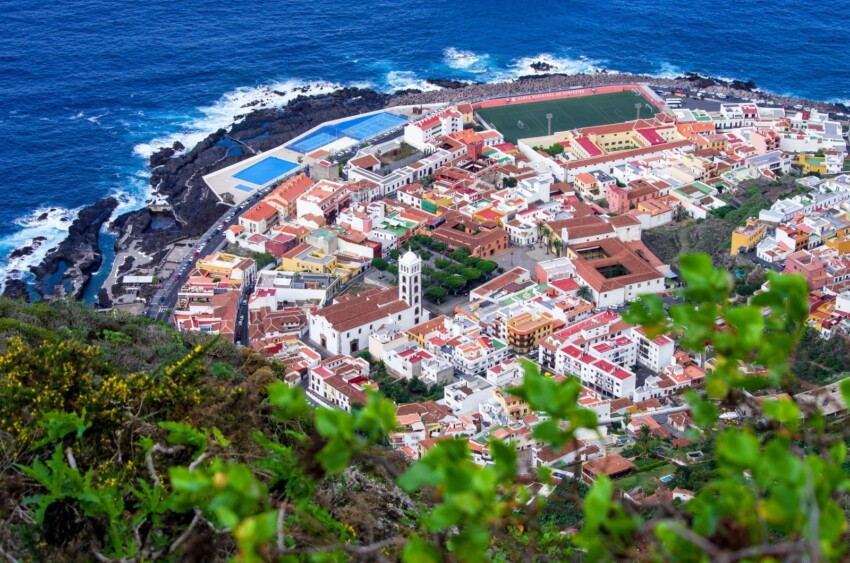
The town of Garachico, one of the most charming maritime villages in the Canary Islands, is located in the north-west of Tenerife between Icod and Punta de Teno, 60 kilometres from the capital Santa Cruz.
The natural pools of El Caleton de Garachico, created after a volcanic eruption in 1706, are exceptional.
Its location makes it an ideal destination for all types of tourism, from maritime to cultural and rural.
Together with Buenavista and Los Silos, Garachico, once the island’s main port, forms the famous low island where one can admire numerous fine religious buildings such as the churches of Santa Ana and Nuestra Senora de los Angeles, the convents of San Francisco and Santo Domingo and the castle of San Miguel.
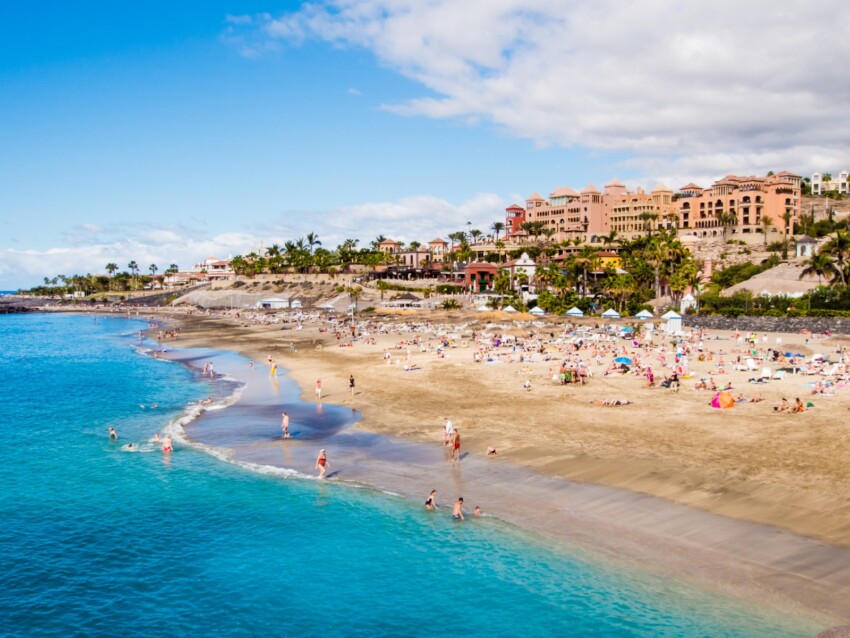
The exclusive resort of Costa Adeje is located along the south-western coast of Tenerife near beautiful beaches including Playa del Dunque, Playa Fanabe and Playa Paraiso.
An ideal destination for discerning travellers and lovers of sandy beaches, glamorous nightlife, luxury hotels and excellent restaurants, Costa Adeje
Among the various activities on offer, water sports, from surfing to windsurfing, from sailing to water skiing, whale watching excursions, the 18-hole Costa Adeje Golf Course and, for the youngest guests, the water parks Siam Park, one of the largest parks in Europe, and Aqualand are very popular.
Numerous designer boutiques and luxury brands line the streets of Costa Adeje.
Nature and hiking enthusiasts will appreciate the famous Barranco del Infierno, the second most visited natural park in Tenerife.
The rural town of Tacoronte is located in the north of the island, 21 kilometres east of Santa Cruz de Tenerife, in the heart of Tenerife’s wine regions.
The Church of Santa Catalina de Alejandria Martyr, the oldest in the town, is one of the most characteristic places in Tacoronte, along with the convent of the Augustine Fathers and the sanctuary of Cristo de los Doloros.
Vineyards and volcanic peaks characterise the surroundings of Tacoronte, a name derived from Tagoror, meaning the place where the Council of Elders meets.
Nearby, within the Barranco de Guyonje, is the important pre-Hispanic archaeological site of Ricos de Tacoronte, while nearby you can visit the hermitages of La Caridad, San Juan and San Jeronimo.
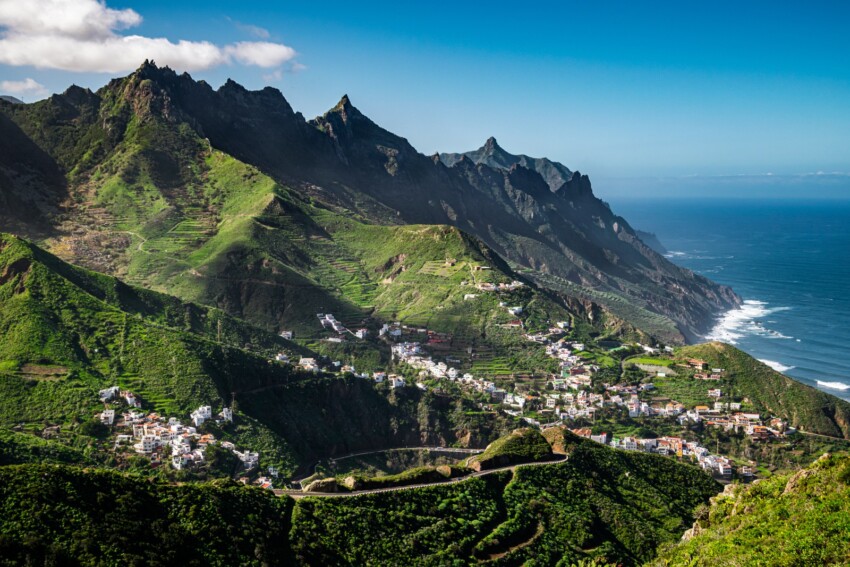
The traditional village of Tegueste lies within a fertile valley in the north of Tenerife at the foot of the Anaga Mountains.
Only known to tourists in recent years, Tegueste offers wonderful accommodation in traditional Canarian rural houses away from the hustle and bustle of the coastal resorts.
Tegueste is located close to the capital Santa Cruz and La Laguna, making it an ideal point for exploring the northern part of the island. The coast, Punta del Hidalgo and Bajamar are only a few kilometres away and can be reached through lush landscapes.
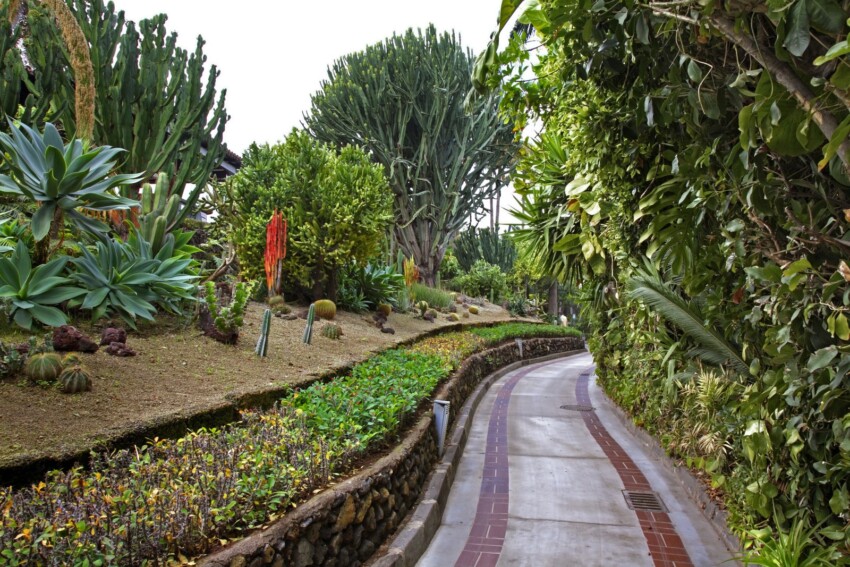
Loro Parque is a wildlife park in Tenerife located along the northern coast of the island just outside the town of Puerto della Cruz.
In addition to housing the largest collection of parrots in the world, Loro Parque includes an aquarium, the Naturavision space and a wide variety of animals including dolphins, sea lions, gorillas, chimpanzees, penguins and orcas.
Founded in 1972, the park covers 135,000 square metres and reproduces various natural habitats such as Planet Penguin, an iceberg inhabited by 200 penguins, and Katandra Treetops, an Australian environment where exotic birds can be fed.
There are numerous shows in the park: during the day there are 5 sea lion shows, 4 dolphin shows, 6 parrot shows, 3 killer whale shows and 9 feature film screenings.
The park also includes an orchid garden with very rare plants.
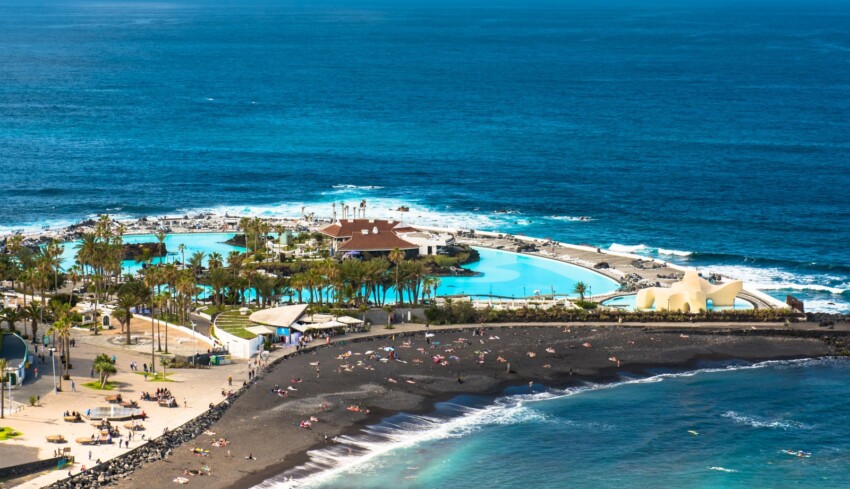
Along the volcanic coastline of Puerto de la Cruz, stretching from the San Felipe castle to the Punta Brava district, behind the Martianez beach so popular with surfers, lies the beautiful Lago Martianez, a complex of saltwater pools designed by architect Cesar Manrique, originally from Lanzarote.
The perfect place to relax or take a refreshing dip, the original complex combines traditional Canarian architecture, lush subtropical vegetation and original statues, and has four pools for adults and three for children.
The 27,000 litres of ocean water, which fill the Lago Martianez pools, is filtered thanks to a complex system.
The saltwater pool area, the largest in the Canary Islands, is served by a restaurant, a bar, a pub, several pergolas and solarium areas.
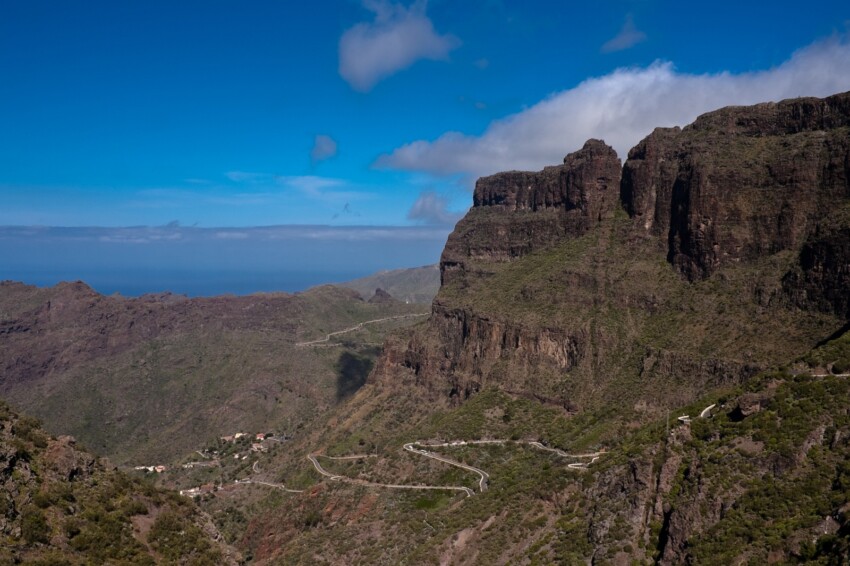
The small mountain village of Masca is located at an altitude of 650 metres above sea level, near the western tip of Tenerife. Its main characteristic is that it was a Guanche village before the Spanish conquest in 1496, which is why it has preserved some of its ancient traditions over the centuries.
The beauty of Masca lies not so much in the village itself, but in the surrounding landscape. Surrounding it are cypress and palm groves and, above all, the Barranco de Masca, a narrow gorge surrounded by high mountains, with breathtaking views and a footpath from the village to Masca beach, to see Tenerife from a different perspective – also a bit tiring, as the path is about 10 kilometres long and, above all, you have to walk backwards to return to the starting point, as the beach is inaccessible due to the high mountains surrounding it.
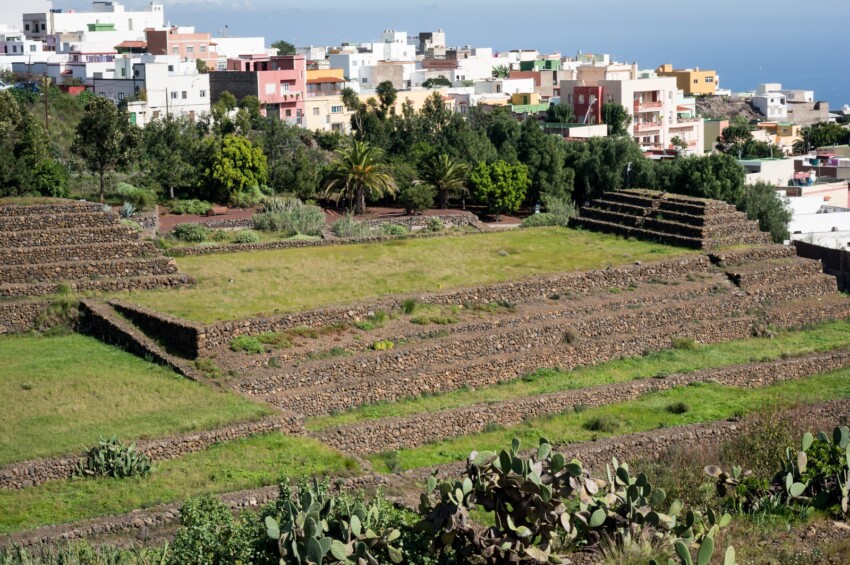
The pyramids of Guimar are rectangular stepped buildings of 5 levels very similar to the Mayan pyramids or the pyramids of the Aztecs. These constructions are located not far from the east coast of Tenerife, near the village of Guimar from which they take their name, and were only discovered in 1991 by the Norwegian anthropologist Thor Heyerdahl.
The 6 pyramids of Guimar, there used to be 9 but 3 structures were dismantled to use their volcanic ashlars as building material, have been part of a 65,000 square metre Ethnological Park open to the public since 1998.
The structures have an astronomical orientation and all have a staircase on the western side from which it is possible to follow the sun on the winter solstice.
The park also houses the Casa Chacona museum where reproductions of indigenous masks and ceramic objects found during excavations are displayed.
The age of the pyramids has not yet been established, but according to Pliny the Elder, the Canary Islands were uninhabited in 600 B.C. but held the ruins of large buildings. However, researchers have concluded that the pyramids were built in the second half of the 19th century for agricultural purposes.
The town of Güimar is located in the south-eastern part of Tenerife, 28 kilometres from Santa Cruz de Tenerife, and is famous for its history and monuments.
In addition to the spectacular archaeological site of the pyramids of Guimar, or Majanos de Chaconne, the city is a modern tourist centre, rich in services and entertainment. Visit the Cueva de Chinguaro, Casa del Paseo, Casa de la Raya, Casa del Buon Retiro and Casa del Santo Domingo.
Surrounded by beautiful landscapes, the city is an ideal destination for lovers of nature, trekking, mountain biking and beaches.
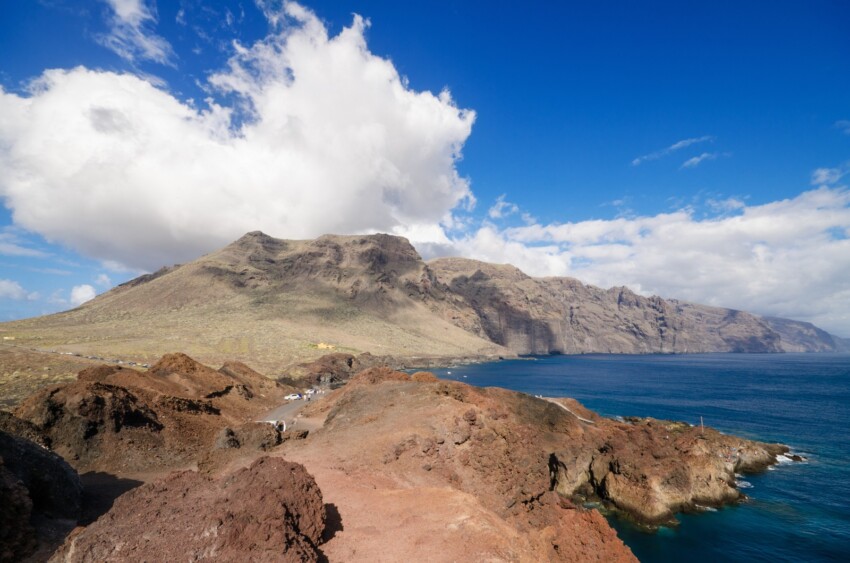
Punta de Teno is located in the westernmost part of Tenerife and is a favourite destination for hikers.
This paradisiacal corner of the island, part of the Teno Rural Park, offers beautiful views of the neighbouring island of La Gomera and the cliffs of Los Gigantes and contains a small beach ideal for snorkelling and an ancient lighthouse, one of the 7 that mark the coast of Tenerife.
The area is the natural habitat of the osprey and numerous other bird species.
To get to Punta de Teno you have to follow the coastal road TF 436 or TF 445, which leave from the urban centre of Buenavista del Norte.
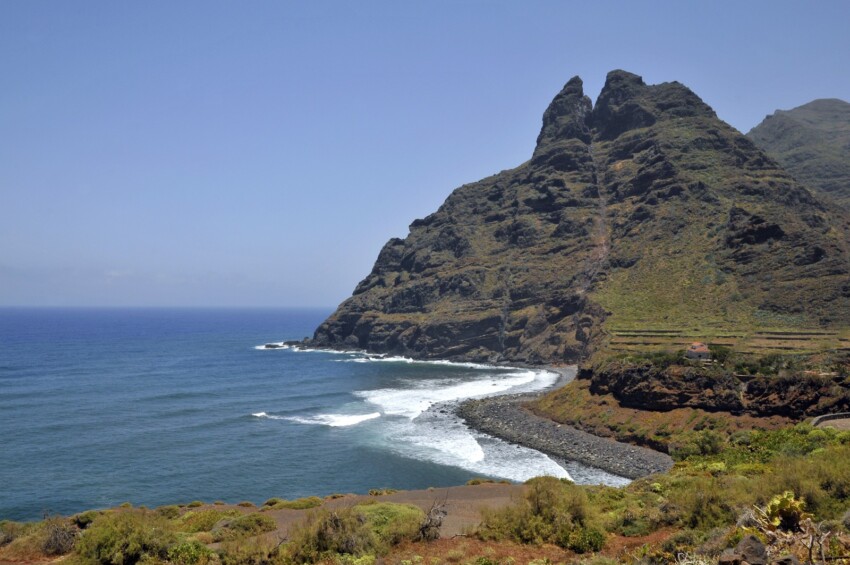
Punta del Hidalgo, or simply La Punta, is a small tourist resort in the municipality of San Cristobal de La Laguna, on the northern tip of Tenerife at the foot of the Anaga Mountains, and is known for its spectacular viewpoint over the Atlantic and the Los Areniscos seawater pool.
This stretch of coastline is characterised by numerous natural pools, including the famous Las Furnias, and several small coves. Playa de San Juan is very beautiful, especially when the sea is calm.
Punta del Hidalgo is located 62 metres above sea level, along the ridge of the Roque del Moquinal hill, and offers numerous tourist facilities including good hotels and excellent restaurants.
In the following map you can see the location of the main places of interest mentioned in this article.
